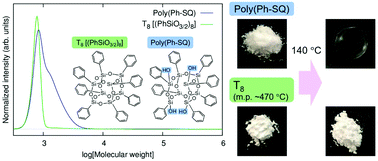Cosolvent-free synthesis and characterisation of poly(phenyl-co-n-alkylsilsesquioxane) and poly(phenyl-co-vinylsilsesquioxane) glasses with low melting temperatures†
Abstract
Thermoplastic poly(phenylsilsesquioxane) [poly(Ph-SQ)] and its copolymers with R-SQ units of linear aliphatic R groups [poly(Ph-co-R-SQ) (R = Me, Et, Pr, and Vi)] were synthesised by cosolvent-free hydrolytic polycondensation from acid-catalysed water–organotrimethoxysilane binary systems. These compounds became transparent glasses with coefficents of linear thermal expansion of ∼1 × 10−4 K−1 and Vickers hardnesses of 50–110 MPa when thermally treated at or above 100 °C. Poly(Ph-SQ) formed a fragile melt with kinetic fragility (F1/2 ≳ 0.8) as high as that of molecular glasses. The low melting temperature and high fragility probably arise from weak attractive π interactions between phenyl groups that readily dissociate on heating, disordered Si–O frameworks, and low average molar mass (∼103 g mol−1). Proton NMR measurements confirmed other weak attractive CH/π interactions between phenyl and R groups in poly(Ph-co-R-SQ). Poly(Ph-SQ) and poly(Ph-co-R-SQ) glasses were hydrophilic and strongly bonded to a glass plate because of the presence of residual SiOH groups, while thermosetting by polycondensation was insignificant at or below 140 °C. The poly(Ph-SQ) glass was brittle, and macroscopic cracks were formed when melted on a glass plate as a result of a thermal expansion coefficient mismatch. Such crack formation was suppressed by incorporating Et-SQ, Pr-SQ, or Vi-SQ units and enhancing structural relaxation.



 Please wait while we load your content...
Please wait while we load your content...